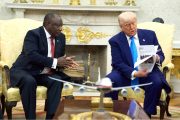So much has been reported but so little is understood of the events that have vacillated in the Middle East. The United States’ allies in the region have begun to fall like dominoes as protests ensue from the Suez in Egypt to Amman in Jordan, following the collapse of the rule of law in Tunisia. The question that looms on the minds of many is "What will happen next?" However, complete understanding of what is transpiring behind the scenes is not possessed by many — in particular the identity of some of the key forces behind the revolutions.
An Islamic Revolution?
On January 28, 2011, in speaking to a crowd of worshippers, Iranian cleric Ayatollah Seyyed Ahmad Khatami declared: “Incidents that are happening in the Middle East and the Arab world should not be regarded simply,” further addressing “those who do not see the realities I clarify that an Islamic Middle East is being created based on Islam, religion, and democracy with prevailing religious principals.”
The Ayatollah went on to issue a proclamation to Western leaders “who still do not want to see the realities that the political axis of the new Middle East will soon be Islamic ruler-ship and a democracy based on religion.”
Khatami continued, likening the 2011 Middle Eastern Revolutions to the 1979 Islamic Revolution in Iran: “All these protests in Egypt, Tunisia, Jordan and Yemen are inspired by Iran's Islamic revolution and these countries are de facto rocked by the aftershock of the Iranian revolution.”
The concept of an Islamic Republic of Egypt is one shared with Egypt’s Muslim Brotherhood.
On October 11, 2007 the Associated Press reported that “The Muslim Brotherhood has laid down its first detailed political platform, which would bar women and Christians from becoming Egypt's president and establish a board of Muslim clerics to oversee the government, reminiscent of Iran's Islamic state.” (Emphasis added).
The article states that in September 2007 the Muslim Brotherhood produced and circulated a blueprint platform for the creation of a Muslim Brotherhood political party — a proposal that Egyptian President Hosni Mubarak has vowed to never permit.
Among the people who got access to the draft platform was Abdel Moneim Said, head of Al Ahram Center for Strategic Studies.
“It establishes a religious state… It’s an assassination to the civic state,” Abdel Said said.
According to The Associated Press, which obtained a copy of the platform, it “calls for the formation of a commission of senior religious scholars, chosen in national elections, to advise parliament and the president.”
In addition to their vision for an Islamic Egyptian republic, the Muslim Brotherhood has unsurprisingly taken advantage of the revolution in support of it.
In a post written by Zeinobia, an online writer for IKHWAN, the Muslim Brotherhood's Official English website, he credits BBC World Affair correspondent Paul Reynolds for having “made a wonderful handbook for overthrowing governments and regimes like the one in Burma.”
Zeinobia finds the handbook to be “interesting because some factors are the key for any successful revolution that wants real change with historical examples from around the globe.”
He outlines the following key factors:
- Widespread public protests, bringing in many different social and economic groups
- An opposition leadership with clear ideas around which people can rally
- The ability to use the media in some form to get a message across
In mentioning the organization’s goals it is imperative that one be aware of its history and affiliations in order to better understand the nature of the revolution.
The following video depicts Communists demonstrating in the Middle East during this past weekend:
Muslim Brotherhood: History and Communist Affiliations
The Muslim Brotherhood was founded in March 1928 by Hassan al-Banna, an outspoken Egyptian schoolteacher and imam who, among many topics, openly discussed Marxism.
Originally established as an Islamic society, the Muslim Brotherhood soon attracted many individuals including Sayyid Qutb.
Born on October 9, 1906 in Musha, Egypt, Sayyid Qutb would go on to become one of the leading Islamic theological scholars for the Muslim Brotherhood. His writings have been credited as the main ideological inspiration for Islamic terrorism.
In his book Social Justice in Islam Qutb discussed a range of issues, including Communism of which he wrote:
Similarly we have no good grounds for any hostility between Islam and the struggle for social justice, such as the hostility which persists between Christianity and Communism. For Islam prescribes the basic principles of social justice and establishes the claim of the poor to the wealth of the rich; it lays down a just principle for power and money and therefore has no need to drug the minds of men and summon them to neglect their earthly rights in favor of their expectations in heaven.
In discussing the connection between the economic ideals of Communism with his views on Islam, Qutb wrote: “…while Communism is compelled to oppose religion in order to safeguard the rights of the workers, we have no need of any such hostility to religion.”
Qutb found validity in Communism’s economic criticism of capitalism, which he equated with Christianity. Its inherent atheism aside, Qutb was in agreement with Communism's secular goals, though he believed that Communism lacked the spiritual aspect that he saw as fulfilled through Islam.
Qutb’s writings have resonated with many of his disciples, including Fathi Yakan — a leader of the Muslim Brotherhood.
In the 1960s, Yakan wrote: “The groundwork for the French Revolution was laid by Rousseau, Voltaire and Montesquieu; the Communist revolution realized plans set by Marx, Engels and Lenin. . . The same holds true for us as well” (Emphasis added).
The Muslim Brotherhood is not oblivious to Qutb’s Leninist influences. In an article, entitled “Four Decades After Sayyid Qutb’s Execution,” Ibrahim al-Houdaiby of the Muslim Brotherhood wrote:
In “Milestones” Qutb presents a manifesto for change, one heavily influenced by Lenin's "What is to be done," with the clear Islamization of its basic notions. He argued that society was suffering from "jahiliyya" (a state of ignorance which preceded the revelation of Islam) and that consequently, there is no room for middle ground between Islamists and their societies. (Emphasis added).
In a 2006 briefing paper — The Roots of Islamist Ideology — published by the Centre for Research into Post Communist Economies, Robert R. Reilly makes note of the fact that Qutb had attended the Communist International, as the principle liaison for the Muslim Brotherhood.
This Qutbo-Leninist factor was just one facet of the Muslim Brotherhood’s linkage to Communism.
The Muslim Brotherhood’s unholy alliance with Communism stretches as far back to the 1940s and '50s during the early days of the Cold War, when Soviet dictator Joseph Stalin had his eyes set on the Communist takeover of Egypt.
“In such countries as Egypt or China, the Communists must pass from the policy of a United Nation front to the policy of a revolutionary bloc of workers and petty bourgeoisie. A party with such a dual composition is both necessary and expedient as long as it facilitates the actual leadership of the revolutionary movement by the Communist party,” Stalin said.
In November 1951, in an article entitled “Detailed Stalin Plan is Coming True,” AP foreign news analyst William L. Ryan noted in The Telegraph-Herald: “Communists have infiltrated heavily in the Moslem brotherhood, now in the forefront of the chaos in Egypt after having been suppressed for some time.”
In October 1954 upon the signing of the Anglo-Egyptian agreement on Britain’s troop withdrawal from the Suez Canal zone, Communist and Muslim Brotherhood protestors took to the streets of Cairo inciting acts of violence as they celebrated.
The subsequent year, in Aleppo, Syria, students with Communist, Socialist and Muslim Brotherhood affiliations violently demonstrated against the visit of Turkish Prime Minister Adnan Menderes and his proposal for a Middle East Treaty Organization (METO; latter renamed the Central Treaty Organization — CENTO) with Iran, Iraq, Syria, Turkey and Britain.
The Islamist and leftist students were heard shouting “Syria refuses imperialist pacts.” Although Syria never did join CENTO, the demonstrations in Aleppo resulted in twenty students and four policemen sent to hospitals — a story all to similar to the events transpiring in Egypt, Jordan and Tunisia now.
In an interview on January 14, 2011, Salah Adly of the Communist Party of Egypt (CPE) referred to the Muslim Brotherhood as “the maximum right” and although he claimed “we do not ally ourselves with them,” he nevertheless said, “but we are coordinating some of the issues of democracy and an end to a state of emergency against the practices of torture and to guarantee free elections.” (Emphasis added).
In discussing some of the problems the Communist Party has had with the Muslim Brotherhood he admits to “alliances made with them in recent years.”
Regardless of how Islamic the Muslim Brotherhood would have one believe it is, it’s communist heritage remains undeniable and worth noting as the dominoes fall throughout the Middle East.
The most significant part of the interview, however, was what it revealed of the CPE’s role in the orchestration of the current revolution in Egypt.
In speaking of the 2011 Alexandria bombing, in which a group of Coptic Christians were killed a few minutes into New Year's Day 2011, Adly condemned the attack and predicted “that the growing sectors of the Christians may join in the coming stage to protest movements demanding democracy, equality and change the conditions prevailing dictatorship.” (Emphasis added)
What did he mean by “coming stage”? Was he alluding to the current revolution? If so, then how could he and the CPE have known of the protests, over a week before they started, unless they were key in its inception?
Although some members, including elder leaders, of the Muslim Brotherhood have been arrested, the truth of the matter is that they have been playing the role of catch-up — initially taking no side in the conflict — eventually joining in on the side of the masses already in revolt.
This would largely seem to discredit many commentators and pundits who regard the Egyptian revolution as a purely Islamic one or one helmed by the Muslim Brotherhood.
Regardless of the outcome of the revolution, even if it results in a Bolshevik-style takeover by the Muslim Brotherhood installing an Islamic theocratic government akin to that in Iran, or even a benign social democracy led by Mohamed ElBaradei, it should be noted that it was not the Muslim Brotherhood that played a significant role in the revolution’s inception.
Historically, as mentioned before, the only other large group to have organized mass protests and demonstrations in Egypt, aside from the Brotherhood, has been the Communist Party, which in turn leads to its role in the 2011 Egyptian Revolution.
Communist Party of Egypt
The CPE was founded in 1942 by Henri Curiel, an Egyptian Jew of Italian ancestry who funneled money, arms and documents to left-wing transnational terror groups in the 1970s.
Among Curiel’s clients were Basques’ ETA, Spain’s Maoist terror group GRAPO, the German Red Army Fraction, the Japanese Red Army, two Israeli Communist parties, the then-outlawed Communist Parties of Iraq, Haiti, Morocco, and Sudan, and five Latin America guerilla forces — including the left-wing Tupamaros in Uruguay.
Another of Curiel’s clients was Sadegh Ghotbzadeth, the spokesman for Ayatollah Khomeini in Paris and following the Islamic Revolution became the Ayatollah’s foreign minister in Teheran.
Curiel’s tie to the Islamic Revolution and governing regime in Iran gives further credence to the connection between radical Islam and Communism.
Today the Islamo-Communist connection in Egypt is observed in their joint coordination, as noted above by CPE spokesman Salah Adly.
The role of the CPE in the events in Egypt is revealed in the website ‘21stcenturymanifesto,’ which admits: “The Egyptian Communist Party is deeply involved in the current struggle against the continuation of the Mubarak dynasty.”
This claim is vindicated by the CPE’s on its website, openly admitting to having participated in the revolution claiming:
Hundreds of patriotic and democratic forces and cadres of our Party in the Cairo district of Abidin and in other places in the capital as well as other demonstrations in Port Said and Alexandria against the inheritance of power to Gamal Mubarak, or an extension for Hosni Mubarak…
Our party has participated in the demonstration raising banners of the Communist Party Banners to fly the red in the field of Abdeen and confirm the position of the Communist Party of rejection of this system. (Emphasis added).
In addition to being active the CPE also expressed its support of the student protesters.
“Hundreds of students of the Egyptian universities have already been attacked; additional to tens who have been prevented from examining, as well as having had their right of expression and demonstration abolished,” the CPE stated.
These remarks are then followed by a call to action: “Thus we demand you to stand in solidarity with us against the arbitrariness and repress, practiced by the authority and the university against the students.”
The CPE called for the adoption of the following demands:
- dismissal of Habib Adli and all the security leaders and officials of agencies entrusted with protecting the country as they claim, which left Egypt for taking advantage of prey and prey to terrorism, it turned out real role in guarding the forces of exploitation and plundering of the poor but generally insist
- accountability of all those responsible for claims broadcast of hatred and violence against the sons of the homeland and approval of alternative policies in the media and education allow for freedom of expression, thought and belief structures of the country and established the existence of a civil state is real.
- accelerate the implementation of laws would solve the problem of the crisis in Egypt, which refers to the likelihood of a real disaster tunnel using sectarianism as one common places of worship.
- provide an opportunity for the public to express its rejection of terrorism and sectarianism, because it is a guarantee to protect the country from disaster of sectarianism.
In addition to Egypt’s Communist Party, Socialists and Communists from around the world have joined in pledging their solidarity.
The Global Socialist Left and Egypt
In an article posted by World Socialist Web Site – a subsidiary of the International Committee of the Fourth International (ICFI) – they reveal the purpose of the Egyptian revolution as follows:
The aim must be to replace the existing state with a workers’ government, controlled by new institutions of popular democracy. Such a government will be the basis for carrying through socialist measures, including the nationalization of all major corporations and banks.
The ICFI openly declares that the purpose or “aim” of the revolution is to supplant the existing government with one of “socialist measures.”
Another view of the forces at play can be observed by the Committee for a Workers’ International (CWI), which expressed its support of the revolutions stating:
The removal of Mubarak would be a great success for the mass movement on the streets. But Egyptian workers and youth can have no faith in any 'national unity' or 'national salvation' government, which would most likely involve remnants of the Mubarak regime and would be dominated by other pro-bourgeois 'opposition' forces…
The Tunisian revolutionary movement is spreading across the Arabic world, from Yemen to Jordan and now most spectacularly to Egypt. Every rotten regime in the region is threatened, sooner or later, with mass street protests and their removal.
The CWI has called for the following demands to be met in Egypt:
- End police repression and brutality – For international solidarity with the Egyptian masses
- For mass workers' action, including a general strike, to overthrow Mubarak and the whole rotten, brutal regime
- For full democratic rights immediately, including the right to assemble, to strike and to organize democratic independent trade unions
- For the creation of democratically elected committees of mass struggle, and defence against state repression, in the workplaces, communities, schools and colleges, linked on local, regional and national scale, to spearhead the resistance
- For rank and file committees of police and soldiers – Side with the masses & purge the officers and hierarchy
- No to sectarianism – For the unity of all workers across religious lines
- No trust in any new 'national unity' regime based on the interests of the ruling class and imperialism
- For immediate and free elections to a revolutionary democratic constituent assembly – For a majority workers' and rural workers' government
- For a living minimum wage, guaranteed jobs, a massive programme of house building, education and health
- End the Egyptian blockade of Gaza – For self-determination for Palestine and for workers' unity and mass action to overthrow dictators across the region
- For the nationalisation of Egypt's big corporations, the banks and large estates and their democratic planning to meet the needs of the masses not an elite
- For a socialist Egypt and a socialist confederation of the region, on an equal and voluntary basis
With the Fifth Column in full force in Egypt, it is likely that the revolution will not rest until a number of its demands are satisfied. When the revolution concludes, despite who comes to/stays in power, it would be wise to look back at the parties involved, such as the Muslim Brotherhood but principally the role of the Communist Party of Egypt and its international Socialist and Communist cadres in order to examine the extent of its influence.
Photo: Demonstrators in support of the violent protestors in Egypt brandish Communist flags in the streets of Amman, Jordan.





